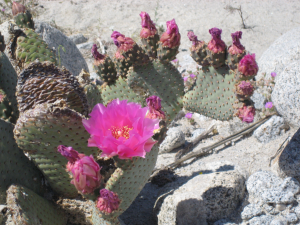 Opuntia spp (Prickly Pear Cactus)
Opuntia spp (Prickly Pear Cactus)
Prickly pear cactus grows throughout the San Diego coastal sage scrub and is common in disturbed soil. Many are also found in the mountains on sunny slopes, usually South facing and down the slopes into the desert. There are many varieties of Opuntia and more than one variety grows in San Diego. Trees for Health has a large prickly pear cactus on the East side of the garden.
The cacti have yellow or pink flowers and red fruit in the fall. The fruits are called “tunas” in Spanish. The fruit is edible, but you must remove the spiny glochids first. Some folks report success burning the spines off in the campfire or rolling the fruit in sandy soil to loosen the stickers. You can also boil the fruit for a minute or two before peeling. But be very careful…you surely don’t want to get a mouthful! Try this link for one way to do it.
The young pads are also edible and are a good source of vitamins, minerals, and mucilaginous (gooey) fiber. The pads, known as “nopales,” are sold commercially in Mexican markets. Nopales are a traditional, and quite effective, remedy for lowering blood sugar and are used by herbalists and traditional healers to treat diabetes.
The fruit and flowers are an important food source for the wildlife in our mountains. Deer, rodents, and birds all browse on cacti for food. The Cactus Wren nests in certain prickly pear species, primarily near the coast.
